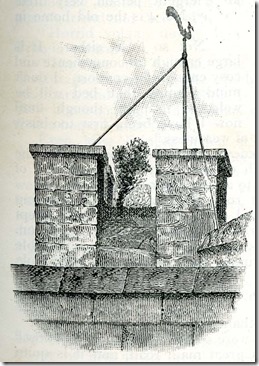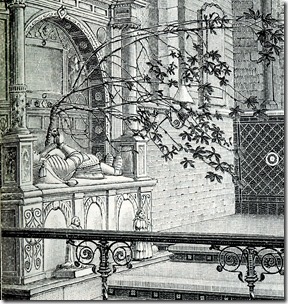In 1900 there were short stories in The Church Monthly about churches with interesting features which included trees growing in odd places – as at Bicknoller St George church near Taunton and Kempsey church in the diocese of Worcester.
At St Swithin’s in Cannon Street, London, there was the “London Stone”, in a stone case with an iron grill said to date back to Roman times. There is now a new office block on the site of St Swithin’s where the London Stone is still on display. I was also fascinated by the account of the carved Anglo-Saxon coffin lid and the oldest carving of a miner (also Anglo-Saxon) which can be seen at Wirksworth church in Derbyshire.
When it is possible to travel again I hope to go and have a look. But I won’t be able see the following as those interesting trees are now gone.
Tree on a tower
 The vicar at Bicknoller St George near Taunton in 1900, the Rev W B S Wood, wrote about the vigorous yew tree which had been growing on the top of the church tower (left) for over 100 years.
The vicar at Bicknoller St George near Taunton in 1900, the Rev W B S Wood, wrote about the vigorous yew tree which had been growing on the top of the church tower (left) for over 100 years.
“In 1878 the tower of the church was restored and I was anxious to have the tree removed and planted in the churchyard, with a tablet giving its size and origin; the parishioners, however, wished it to remain, and although it was cemented all round, it still lives.
“There is a very large yew tree in the churchyard and birds eat the berries on the tower, leaving the kernels, and I imagine in olden days, when the tower mortar was soft, one of these kernels took root.”
It was stated in the magazine that the height of the tower was 60ft, and the height of the yew tree on it 2ft 8ins (81cm) with a girth of 12 ins (30.5cm).
Tree inside a church
 It was recorded in The Church Monthly in 1900: “The church of Kempsey, in the diocese of Worcester, is remarkable for the chestnut tree growing out of the tomb of Sir Edmund Wylde in the chancel (right).
It was recorded in The Church Monthly in 1900: “The church of Kempsey, in the diocese of Worcester, is remarkable for the chestnut tree growing out of the tomb of Sir Edmund Wylde in the chancel (right).
“Sir Edmund held a lease of the Rectory Manor under the Dean and Chapter of Worcester, and was lord of the manors of Glazeley and Endon Burnell (Co. Salop). He was Sheriff of Worcestershire in 1620, in which year he died, leaving a son, Edmund, the last of the Wyldes of Kempsey.
“The tree, which springs fro the recumbent effigy of the knight in full armour (with a real sword and helmet), was flouring in 1849. when Mr J Noake in his Rambler in Worcestershire speaks of it as follows: ‘I was led to enquire the cause, and found that some years ago the then sexton of the church, who was known among the younger fry as a pertinacious stickler for propriety, observing a lad playing with a horse chestnut when he ought to have been digesting the sermon, gave him a fillip on the ear with one hand, and threw the chestnut away with the other; the chestnut alighted on the top of the monument where, in course of time, it formed mould to itself and gradually shot out.’”
The tree, which was carefully protected during the restoration of the church in 1865, died in 1895.
Material from The Church Monthly reproduced with the kind permission of Aysgarth Parochial Church Council.